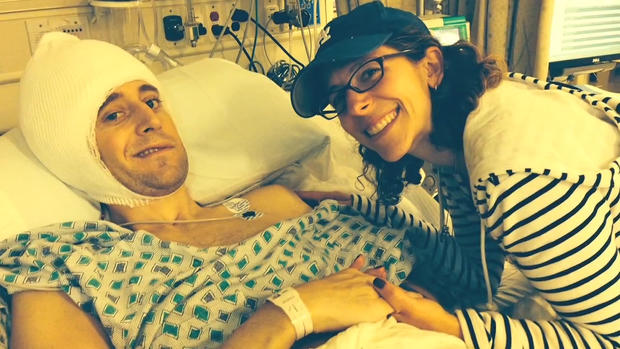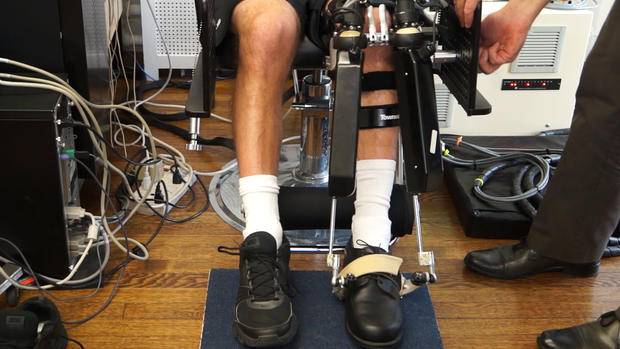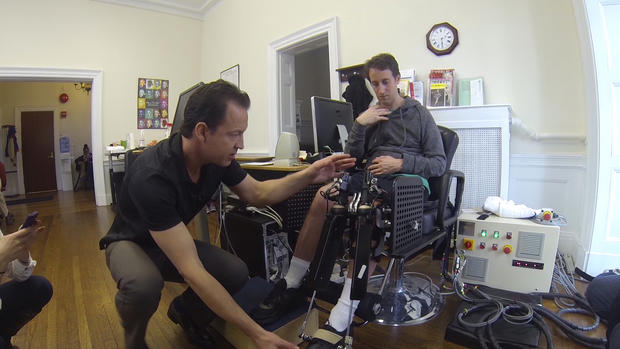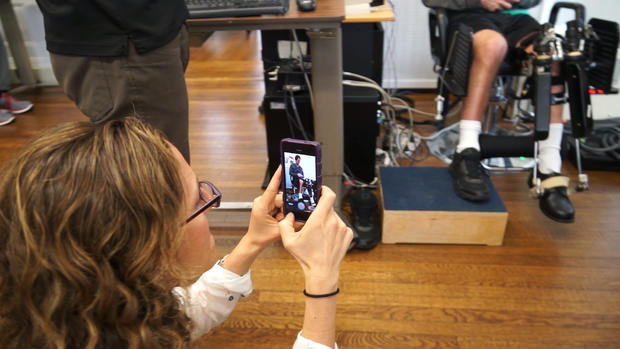How robotic rehab may help young stroke victim reclaim future
A stroke was the last thing Jessica Berman suspected when her husband called frantically during her workout last August, telling her to come home.
To her, Brad Berman was the embodiment of great health: a vice president and tax director at GE Asset Management, he ran marathons with his wife, ate well and exercised frequently. But when Brad, then 37, called, he was slurring his speech and complaining of headaches.
Jessica made the 1.5-mile drive home only to find the father of their two young boys lying on the kitchen floor shaking with his arms in the air, but still conscious. He was having a stroke, a medical emergency that claims almost 130,000 lives each year.
"Brad is the healthiest person I know, but I could have never imagined that he was having a stroke," Jessica, his wife of nine years, told CBS News.
"The message is that this could happen to anybody," she said.
Now, Jessica is raising money to purchase a robotic technology called the Anklebot that professionals say could enhance her husband's rehabilitation and might even help him reach his ultimate goal - running again.
"I have young kids" Brad told CBS News eight months after his stroke. "I would like to be able to run around with them and do everything I used to do."
A stroke occurs when oxygen-rich blood flow to the brain is interrupted, causing cells to die within minutes. About 85 percent of strokes are ischemic, caused by clots that obstruct a blood vessel to the brain.
Brad experienced a less common but most serious type called a hemorrhagic stroke, also known as a brain bleed, which occurs when a blood vessel in the brain ruptures.
The cause of his stroke was a brain arteriovenous malformation (AVM), a developmental defect that causes a tangle of arteries and veins in the brain. AVM typically does not cause symptoms unless it ruptures, according to the Mayo Clinic.
The stroke severely affected the left side of his body. Brad needed emergency surgeries to remove a part of his skull and repair the blood vessel abnormalities. He was hospitalized for four months.
Eight months after the brain bleed, doctors call his recovery to date remarkable for how far he's come.
But they're quick to point out he's only in the "infancy" stages of his recovery. He still faces deficits with his movement and ability to complete daily activities.
When it comes to movement and specifically walking, one problem in people who have had a stroke is that the muscles in the front of the shin that help lift the foot become weakened while the calf muscle stiffens.
This prevents a person from being able to lift one muscle in their foot while pushing down another, an inversion and eversion of the foot that translates into the ability to walk on the ground.
That's where the Anklebot comes in.
The Anklebot is a robotic exoskeleton mounted to a knee brace and custom shoe that was designed by MIT engineers to strengthen these muscles that are so crucial to a person's gait, explained Brad's rehabilitation physician, Dr. Dylan Edwards, director of the Non-Invasive Brain Stimulation and Human Motor Control Laboratory at Burke Rehabilitation Center in White Plains, N.Y.
The device is attached to a computer, and during therapy sessions, the wearer follows along with a game or task on the screen, such as trying to kick a soccer ball from one side of the field to another.
Conventional physical therapy may include similar tasks, but Edwards explained these methods sometimes fall short in the number of repetitions. A minimum number of repetitions is often required with each session to translate into meaningful progress.
The Anklebot can do some of the work for patients a human physical therapist can't, and deliver a higher number of repetitions to the muscles.
While there's no evidence to say the Anklebot will help a person improve better than a physical therapist, physical therapy requires an amount of effort on the part of a physical therapist that can't be maintained over the course of multiple sessions per day, said Edwards.
"This is a really key distinguishing factor of this technology from regular therapy sessions," he said. "They can tirelessly deliver this required dose."
What's more, the device can reduce its support during tasks as a patient improves, based on the progress recorded in the computer.
Over time, the hope is that patients gain an ability to complete the tasks without the robotic support, and eventually can wear the device while walking on a treadmill or performing other activities as part of their rehabilitation.
Burke Rehabilitation has the Anklebot on loan from MIT. CBS News joined Brad as he tried it on for the first time.
A loaner won't be enough to give Brad the repetitions he needs, prompting his wife Jessica to spearhead a fundraising effort on Crowdrise to get the hospital its own Anklebot -- a program that will cost more than $600,000.
Since the Bermans' ultimate goal was to get Brad running again, Jessica was determined to spare no effort to help build this program - taking her on a path unlike she'd had any experienced in her job as Deputy General Counsel for the NHL.
To create a program at a hospital, she would need to speak to researchers, medical experts, budget staff, administrative and marketing personnel. And that's before arguably the hardest part - raising the necessary funds.
Through Crowdrise, under "Run 4 Brad," the Bermans have organized fundraising events built around fitness. The events include family, friends and even kids running for Brad in races. They have two coming up June 8th and 13th in Westchester County, New York.
To date, she has helped raise more than $240,00 for the program.
Once she surpasses her Anklebot goal, she'll put any funds towards research on AVM so others like Brad have better available treatment options that could prevent them from suffering a devastating stroke.
The Anklebot is not the only robotic tool Brad may use.
Burke offers upper-extremity robots, such as the Handbot. In addition, there are devices that improve wrist function to help with grasping. "We are hoping to have really a gymnasium of robots for different body parts, but this is not typical around the country or around the world, so we are really trying to be leaders in this area," Edwards said.
And that in part is thanks to the remarkable efforts of Jessica, he added.
"We are just thrilled that they've decided to involve us and to have confidence in us to be able to help Brad and others like Brad," Edwards said.
Brad has come a long way - Jessica keeps a journal of her husband's progress, since it's sometimes tough to see day-by-day progress - but he still has a long way to go to reach his goal.
"From what I understand, recovering from something like this a true marathon... which resonates with us," she said.
"We frequently reminisce that we were on vacation for the weekend (before the stroke) and we were talking about how lucky we were in that moment, and you don't think that three weeks later your life can be turned upside down. But it can happen to anybody at any moment without any warning, and so you really want to fund research and have available these types of technologies for the people who need them."
Brad calls his wife the "quarterback," and realizes his care and the fundraising efforts are a full-time job for his wife. But he knows the efforts will pay off for him and others in his situation.
"I met a lot of people through this, in the hospitals and in rehab, who have had similar things happen to them. Some of them in a lot worse shape than I am," said Brad. "So I am hoping that out of this, those people can benefit."







